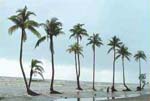 Kuakata, a panoramic coastal area, is located in the Patuakhali district of Bangladesh. Kuakata has an extensive sandy beach (30 km long and 6 km wide) from where one
Kuakata, a panoramic coastal area, is located in the Patuakhali district of Bangladesh. Kuakata has an extensive sandy beach (30 km long and 6 km wide) from where one
can get a full view of both the sunrise and the sunset.
Locally known as “Sagar Kanya” (daughter of the sea), the long strip of dark marbled sand beach at Kuakata has an idyllic natural setting. On the eastern side of the
beach, a long sandy bed of red crabs stretches out. This sandy beach has gentle slopes into the Bay of Bengal. Kuakata is also a sanctuary for migratory birds that
generally appear in winter.
The name Kuakata originated from the Bengali word “kua” (well) which was dug on the shore by the early Rakhain settlers. The Rakhain community landed on Kuakata coast
in the 18th century after being expelled from Arakan in Myanmar by the Mughals.
Beholding the full moon while roaming the Kuakata beach can be quite an extraordinary experience. The songs of the swift wind coupled with the rhythmic roar of mighty
waves are sure to enchant the tourists. Most locals keep themselves busy with fishing at midnight.
During monsoon one gets drenched in the rain serenading the sea. The tourists can blissfully take a long shower amidst frequent waves. There is a boat permanently
embedded in the sands of the beach. Locals say that this boat has been here for generations. During high tides, the tourists must be cautious as uprooted trees are
often thrown on the beach by the sea.
If you closely look around, you may find a rain-loving yellow bird gleaming on a jhau tree. On the eastern end of the beach is Gangamati Reserved Forest, an evergreen
mangrove forest. When the Rakhains settled in the area in 1784, Kuakata was part of the larger Sundarbans. However, the Sundarbans is now at a distance of one-hour by
speed boat. As a mangrove forest, Gangamati, like the Sundarbans, offers some protection against tidal surges. However it too is being threatened by logging and
deforestation. The best way to reach the forest is on foot or by a bike along the beach where a flock of flag flying fishing boats can be seen trawling the coast. Late
afternoon is a perfect time to watch the sun cast shadows on the strangely shaped exposed mangrove roots.
Kuakata is a place of pilgrimage for both the Hindu and the Buddhist communities. People arrive there during the festival of ‘Raas Purnima’ and ‘Maghi Purnima’. On the
two occasions, the pilgrims bathe on the bay and participate in the traditional celebrations. One may also visit the 100-year old Buddhist temple where the 36 feet-
long statue of Gautam Buddha, and two 200-year old wells are located.
Fishermen’s village is another place one can visit and observe their simple lifestyle. Adventurous tourists may also go for fishing with them. One will find the
fishermen coming back from the sea and can purchase some fresh hilsa from them and by the side of the village, there are some local restaurants where one can get the
hilsa cooked.
The government and local business owners have made significant developments over the years to attract tourists. Nowadays, local people are more supportive of the
tourists and communications have improved notably. A new police station was built in 2007. Accordingly, the law and order situation on the open beach, even at night,
has improved significantly.
-With The Daily Star input




















